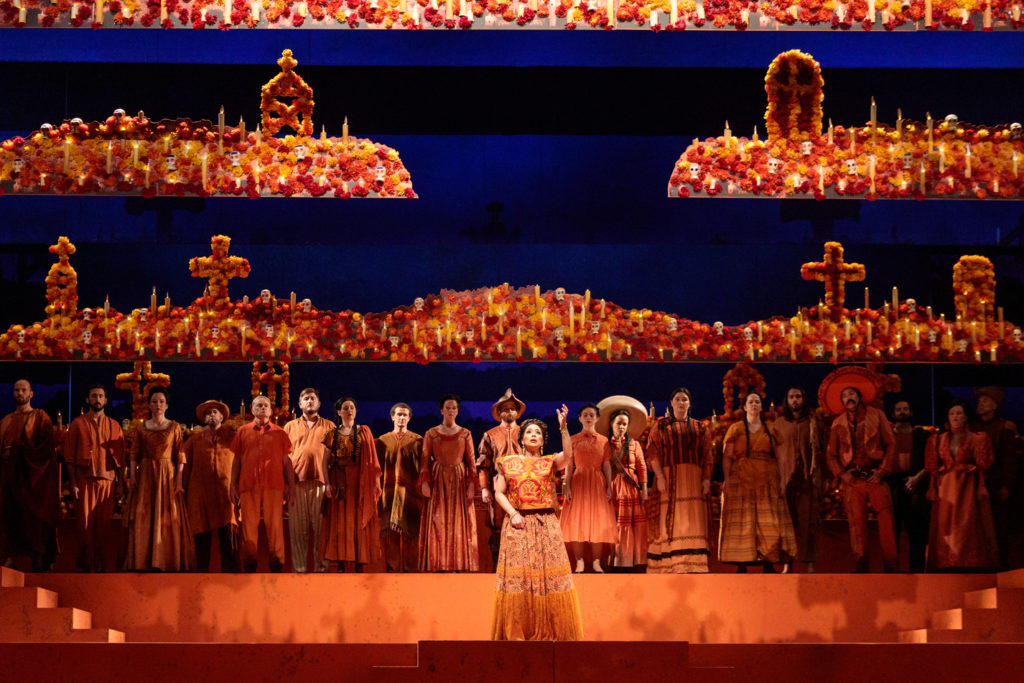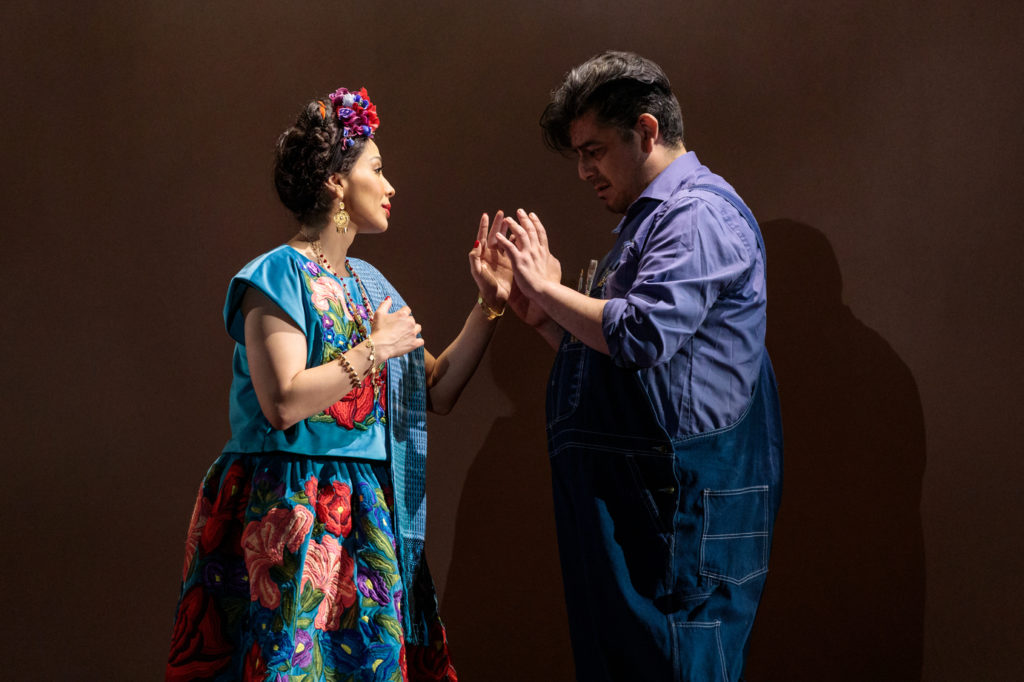Dazzling Production of ‘Frida y Diego’ Opens San Diego Opera Season at Civic Theatre
El último sueño de Friday y Diego, San Diego Opera’s long anticipated commissioned work from composer Gabriela Lena Frank, opened Saturday at Civic Theatre in a dazzling production headed by a stellar cast of singers. Frank’s shimmering score and Jorge Ballina’s radiant set transported the audience to painter Diego Rivera’s native Mexico and to the garrulous underworld as imagined by Mexican folklore.
Librettist Nilo Cruz chose the popular Mexican festival the Día de los muertos [Day of the Dead] on which to unfold his inventively imagined story of Rivera’s attempt to contact his beloved deceased wife Frida Kahlo in order to alleviate his own fear of death as well as his lack of faith. Because it is believed that on the Day of the Dead members of the underworld may be given—under special circumstances—a one-day pass to return to the world of the living, Rivera hopes this magical day will bring his Frida back to him.The opera moves back and forth between the world of the living and the underworld, where Catrina, the Keeper of the Souls, rules. When Frida learns that Diego has wished for her return on the Day of the Dead, at first she refuses to return because of the suffering she endured in that realm. But Leonardo, a young man of the underworld obsessed with impersonating Greta Garbo in her Queen Christina movie role, persuades Frida to return. After some fractious score settling in the real world, Frida and Diego reconcile, which allows Diego to appeal to the God of the underworld to allow him to follow Frida back to the underworld, and Diego dies peacefully.
Guadalupe Paz gave an overpowering account of Kahlo, displaying a certitude grounded in the experience of the painter’s tumultuous life, and Paz’s resplendent, colorful mezzo-soprano filled the theater with gleaming self-confidence. Alfredo Daza skillfully portrayed a Rivera marked by the willfulness of international celebrity, yet secretly haunted by his mortality, and Daza’s rich baritone amply communicated both aspects of Rivera’s personality.
As the imperious Catrina, Maria Katzarava’s bold dramatic soprano soared easily over the orchestra, and her speaking voice emitted sharp, sarcastic cackles that further developed Catrina’s imposing character. Countertenor Key’mon W. Murrah’s Leonardo suggested an earnest youth with an unconventional fixation, but his clear and well-focused singing ingratiated him to the Civic Theatre audience.
Like the chorus in Mussorgsky’s Boris Godunov, as the denizens of the underworld, the chorus of this opera provides an important character in the story, and the well-tuned ensembles of the San Diego Opera Chorus, directed by Bruce Stasyna, greatly enriched the opera’s tonal palette. Under the direction of Roberto Kalb, the orchestra gave a riveting account of Frank’s colorful but elegantly transparent score that deftly tailors individual instruments and combinations to specific characters.
Ballina’s opening scena immediately suggested a dream world: a dark, multi-layered cemetery with hundreds of twinkling votive candles. When illuminated—Victor Zapatero devised the subtle lighting scheme—the scene took on a dusky dark orange hue. To signal a scene change to the underground world, the sections of the cemetery ascended to hover over the activity below, where a robust marigold color bathed all these underground scenes and denizens. Later scenes at Frida’s Casa Azul glowed in a deep, almost midnight blue.
Lorena Maza’s insightful stage direction provided reasonable shape to the several crowd scenes, and she wisely kept interactions between the major characters focused front and center on the wide Civic Theatre stage.
Eloise Kazan’s costumes favored flowing robes for the underworld crowd, and colorful period attire for the folks in the real world. Her bright, contrasting colors for Frida’s dresses stood out majestically.El último sueño de Frida y Diego follows in the great tradition of mythological operas such as Oedipus Rex, Orfeo ed Euridice, and Medea, except that its title characters are actual historical individuals whose lives have acquired mythological status in contemporary culture. Frank and Cruz have fashioned the mythology of Kahlo and Rivera into a fascinating opera, and San Diego Opera has turned their vision into a bold production. San Francisco audiences will have to wait to experience El último sueño in June, 2023, at their War Memorial Opera House, but San Diegans have three more chances to attend San Diego Opera’s production: November 1, November 4, and November 6 at the Civic Theatre.



Opening night was a beautiful celebration of our multicultural community. The pre-show food and music and elegant opera goers, many with a nod to Frida in their attire, just set the tone for the amazing production. The whole production was a feast for your senses; you could feel the warmth of the candles in the swelling, emotional and authentic Spanish that is so familiar to us. The joyous fiesta following the opera was just frosting on the tres leches!
Totally agree with Jan!!
She spoke for me!
I agree with the comment above. The most diverse scene I’ve encountered st SD Opera! And thank you Ken, for the delightful account. I enjoyed reliving it through your narrative.